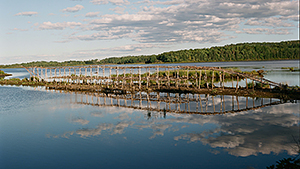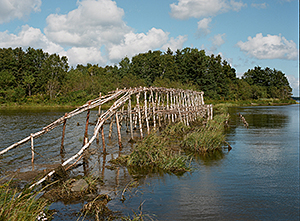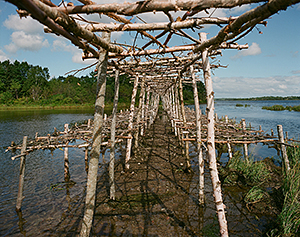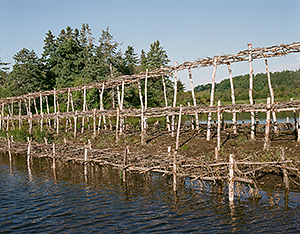Home page
Installations
Exhibiitions
Editions
Projects
Invitations
Biography
Texts
Links
ContactFor
a Landscape of Water
Publics Benches
The Fallen Tree
Collateral
Gains
At the end
ot the tunnel / Grotesque / Documentary
The
Sand Quarry in the Mangrove Swamp
The Landing Place
Dialogue on
Rainy Days
The Carter
The Foutain
The Waste land
Carbolux
The Camp of
l'Ermitage
The Barque
Long-viiew-la-Masure
14 Benches face à
face
Balance
The
Home
of Alders
+ Bruni/Babarit's website
|
Installations
The Landing
Context :Commissioned
by All-of-us Society for Art Presentation in connection with
Antigonight: Art After Dark festival, 16-17 September 2016]
Specifications:
Place: Antigonish Harbour, Nova Scotia, Canada; the former
causeway at the end of the Landing Road walking track, flooded at high
tide; private property of Dale Archibald, architect
Dates: Constructed between 26 August and 16 September 2016; dismantled by 31 October 2016
Materials: Approximately 60 posts and 100 piles, around 130 sleepers,
approximately 60 long poles for horizontal crossbars and branches for
the trellis mesh for the “tables,” all derived from raw birch harvested
from the woods of John Quinn, blueberry grower and farmer from
Lochaber, 5-6 reels of wire
Description: Five rows, one central and two shorter ones on each
side. Each row is covered with an open mesh to catch plant matter
brought in by the tides. They act as “tables” on the side rows
and a “roof” on the central part. The five rows define the levels
of the structure.
Dimensions: A rectangle approximately 60 metres long by 10 metres wide,
maximum, 2 metres ascending to 3 metres high progressing from east to
west
Participation: Collaboration with Fenn Martin, Austin
Carter, Tila Kellman, with assistance from Jocelyn Gillis (Antigonish
Heritage Museum), Bart Wainwright, Leah Campbell, Nancy Turniawan,
Amberlee Boulton
THE LANDING
L’ATTERRISSEMENT
Gilles Bruni (Clisson, France) + Fenn Martin (Antigonish, Nova Scotia)
Antigonish Harbour, Antigonish, Nova Scotia
24 August-31 October, 2016
Art in the Creation of Landscape
Gilles Bruni, French earth artist with an international practice, is
collaborating with Fenn Martin, Antigonish ceramic artist, builder and
organic farmer, to create our region’s first “earth art” installation
on the flooded old roadway to the historic Antigonish
Landing. Here, land and water, fish and birds, and the
Mi’kmaq, Scots, Irish and Acadian peoples all came together in various
modes of exchange, with their different aspirations and needs.
These physical and cultural forces shaped and continue to shape the
landscape that we see today.
Landscape, Gilles Bruni says, is never just nature, but the expression
of competing natural and social forces acting upon it. Today,
these forces are undergoing the rising impact of climate change.
In our area, the principal visible effect is predicted to be sea level
rise, which is probably accelerating cliff erosion already along
Antigonish County beaches and flooding of The Landing site.
Changing temperatures and water levels will also affect sea and plant
life.
In visualizing the competing interests and natural forces that produce
a landscape, Bruni looks for processes that shape a site. After
days of watching the tides overflow and expose the site, the marsh life
and detritus that accompany the tide, and of studying the social
history of the Landing and Antigonish Harbour, he found a common
process at work in both human and natural worlds: SEDIMENTATION.
Layers of eel grass and mud appear daily; birds arrive to hunt incoming
sea life. The Mi’kmaq hunted, trapped, fished, made baskets and
hockey sticks, and practiced subsistence farming; the Europeans brought
their agriculture, forestry, fishing, boat-building and commercial
trading. Today, there is interest in conservation and
recreation. Layer upon layer, these influences have been
deposited on the Landing and continue to leave their marks.
Bruni gives us sedimentation as layers descending on the old
roadbed. The lowest layer of birch trellises is underwater at
high tide, catching detritus, while the highest allows visitors to walk
beneath it and marks where future water levels might be. The ramp
invites your imagination to ascend into the landscape and imagine its
past and future—and your place in it. While the experience of The
Landing can be understood in many different ways, by placing you at the
centre of the installation and directing your attention up, down, and
outward, the The Landing participates in creating landscape, understood
here as a human activity. You might even think of this as a
performance.
Tila Kellman
Curator, The Landing
ASAP Art Centre, Antigonish
|
|

[ + ]

[ + ]

[ + ]

[ + ]
|





